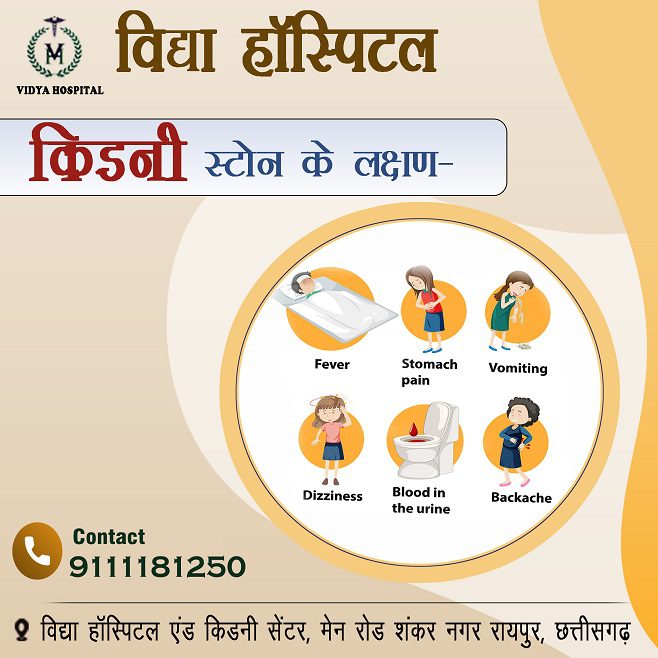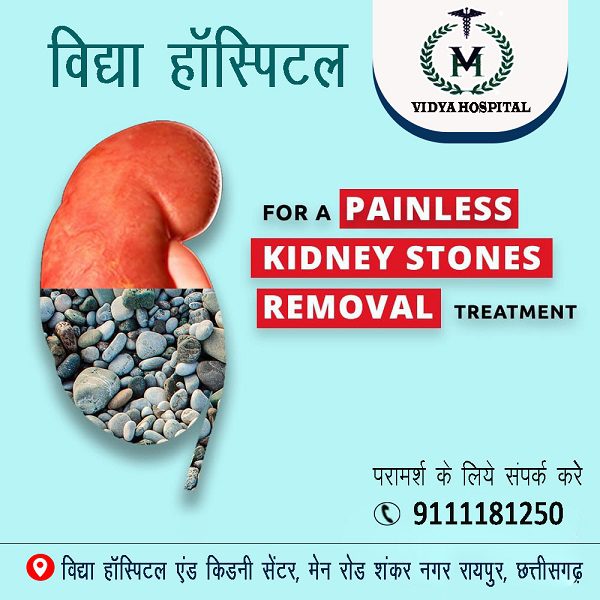Contents
- 1 What’s a kidney stone?
- 2 What causes kidney stones?
- 3 BOOK CONSULTATION WITH THE BEST KIDNEY STONE EXPERT IN RAIPUR NOW
- 4 OR
- 5 EMERGENCY- CALL- 9111181250 24 hour Emergency and Ambulance services available.
- 6 BOOK CONSULTATION WITH THE BEST KIDNEY STONE EXPERT IN RAIPUR NOW
- 7 Vidya hospital and kidney centre
What’s a kidney stone?
A stone in your kidney is an irregularly-shaped solid mass or crystal that can be as small as a grain of sand up to the size of a golf ball. Depending on the size of your kidney stone (or stones), you may not even realize that you have one. Even small stones can cause extreme pain as they exit your body through your urinary tract. A large kidney stone can get trapped in your ureter (the tube that drains urine from your kidney down to your bladder). When this happens, the stone can cause bleeding and keep urine from leaving your body. You may need surgery for a stone that can’t pass on its own.
Who’s most likely to get kidney stones? What are the risk factors?
- Not drinking enough liquids.
- Having a diet that includes the substances that form the stones (phosphate, for example, is in meat, fish, beans and other protein-rich foods).
- Having a family history of kidney stones.
- Having a blockage in your urinary tract.
- Hypercalciuria (high calcium levels in your urine).
- High blood pressure.
- Diabetes
- Obesity
- Osteoporosis
- Gout and cystic fibrosis.
- Kidney cysts.
- Parathyroid disease.
- Inflammatory bowel disease and chronic diarrhea.
- Some surgical procedures, including weight loss surgery or other stomach or intestine surgeries.
- Meats and poultry (animal proteins).
- Sodium (diets high in salt).
- Sugars (fructose, sucrose and corn syrup).
What’s the urinary tract? How does it work?
Your urinary tract is vital to your body because it gets rid of waste and extra fluid. It’s made up of both your kidneys, two ureters, your bladder and your urethra. Each organ has an important job (in the following order):
Kidneys: Your fist-sized, bean-shaped kidneys are located on either side of your spine, below your rib cage. Each day they filter 120 to 150 quarts of your blood to remove waste and balance fluids. Your kidneys make one to two quarts of urine every day.
Ureters: After your kidney creates urine, the liquid travels through the tube-shaped ureter to the bladder. There is one ureter per kidney. Kidney stones can pass through the ureters or, if they’re too big, get stuck in them. You may require surgery if the stone is too large.
Bladder: Between your hip bones is your bladder, an organ that stores urine. It stretches to hold about one and a half to two cups.
Urethra: Like a ureter, your urethra is a tube through which urine passes. It’s the final stop of the urinary tract where your urine (and a kidney stone) leaves your body. This is called urination.
How long does it take a kidney stone to form?
You can have kidney stones for years without knowing they’re there. As long as these stones stay in place within your kidney, you won’t feel anything. Pain from a kidney stone typically starts when it moves out of your kidney. Sometimes, a stone can form more quickly — within a few months. Talk with your healthcare provider about your risk factors. They might do a 24-hour urine test to check how quickly you develop stones.
What are the most common types of kidney stones?
The most common type of kidney stone is a calcium oxalate stone. This type happens when calcium and oxalate combine in your urine. It can happen when you have high quantities of oxalate, low amounts of calcium and aren’t drinking enough fluids. Stones caused by uric acid are also fairly common.
What are the symptoms of kidney stones?
- Feeling pain in your lower back or side of your body. This pain can start as a dull ache that may come and go. It can also become severe and result in a trip to the emergency room.
- Having nausea and/or vomiting with the pain.
- Seeing blood in your urine.
- Feeling pain when urinating.
- Being unable to urinate.
- Feeling the need to urinate more often.
- Fever or chills.
- Having urine that smells bad or looks cloudy.
- Smaller kidney stones may not cause pain or other symptoms. These “silent stones” pass out of your body in your urine.

What causes kidney stones?
Kidney stones are formed from substances in your urine. The substances that combine into stones normally pass through your urinary system. When they don’t, it’s because there isn’t enough urine volume, causing the substances to become highly concentrated and to crystalize. This is typically a result of not drinking enough water. The stone-forming substances are:
- Calcium
- Oxalate
- Uric acid.
- Phosphate
How are kidney stones diagnosed?
Imaging tests: An X-ray, CT scan and ultrasound will help your healthcare provider see the size, shape, location and number of your kidney stones. These tests help your provider decide what treatment you need.
Blood test: A blood test will reveal how well your kidneys are functioning, check for infection and look for biochemical problems that may lead to kidney stones.
Urine test: This test also looks for signs of infection and examines the levels of the substances that form kidney stones.
How are kidney stones treated?
- Ureteroscopy: To perform this procedure, a small instrument called an ureteroscope is inserted in your urethra, through your bladder and into a ureter. This instrument shows the kidney stones and then retrieves them in a surgical “basket,” or breaks them apart using a laser. These smaller pieces of the kidney stones are then easily able to exit your body through your urinary tract.
- Shockwave lithotripsy: In this procedure, you’re placed on a special type of surgical table or tub. High-energy shockwaves are sent through water to the stone(s). The shockwaves break apart the stones, which are then more easily able to exit your body.
- Percutaneous nephrolithotomy: When kidney stones can’t be treated by the other procedures — either because there are too many stones, the stones are too large or heavy or because of their location — percutaneous nephrolithotomy is considered. In this procedure, a tube is inserted directly into your kidney through a small incision in your back. Stones are then disintegrated by an ultrasound probe and suctioned out so that you don’t have to pass any fragments. A urethral stent is placed after the procedure (an internal tube from the kidney to the bladder which is removed one week later). Patients are typically kept overnight for observation.

How long does it take to pass a kidney stone?
A stone that’s smaller than 4 mm (millimetres) may pass within one to two weeks. A stone that’s larger than 4 mm could take about two to three weeks to completely pass. Once the stone reaches the bladder, it typically passes within a few days, but may take longer, especially in an older man with a large prostate. However, pain may subside even if the stone is still in the ureter, so it’s important to follow up with your healthcare provider if you don’t pass the stone within four to six weeks.
BOOK CONSULTATION WITH THE BEST KIDNEY STONE EXPERT IN RAIPUR NOW

OR
EMERGENCY- CALL- 9111181250
24 hour Emergency and Ambulance services available.
How can I prevent kidney stones?
Drink water. Drink at least six to eight 8-ounce glasses every day (about 64 ounces). Staying hydrated helps you urinate more often, which helps “flush away” the build up of the substances that cause kidney stones. If you sweat a lot, be sure to drink even more.
Limit salt. Eat less sodium. You may want to connect with a dietician for help with planning what foods you eat.
Lose weight. If you’re overweight, try to lose some pounds. Talk to your healthcare provider about an ideal weight.
Take prescriptions. Your healthcare provider may prescribe some medications that help prevent kidney stones. The type of medication may depend on the type of stones you get.

Should I cut calcium out of my diet if I develop calcium oxalate kidney stones?
If you have calcium oxalate stones, the most common type, it’s recommended that you have a diet higher in calcium and lower in oxalate.
Foods that are high in calcium include:
- Cow’s milk.
- Yogurt
- Cheese
- Broccoli
- Kale
- Calcium-fortified juices.
- Dried beans.
- Salmon
- Calcium-fortified hot cereal.
Foods that are high in oxalates include (reduce these in your diet):
- Spinach
- Rhubarb
- Strawberries
- Tea
- Dried peas and beans.
- Nuts and nut butters.
- Wheat bran.
- It’s also important to drink plenty of fluids to dilute the substances in your urine.
What’s the outlook for kidney stones?
The outlook for kidney stones is very positive, although there is a risk of recurrence (the stones coming back). Many kidney stones pass on their own over time without needing treatment. Medications and surgical treatments to remove larger kidney stones are generally very successful and involve little recovery time. It’s possible to get kidney stones multiple times throughout your life. If you keep developing kidney stones, your healthcare provider may work with you to discover why the stones happen. Once the cause is found, you may be able to make dietary changes to prevent future stones.
BOOK CONSULTATION WITH THE BEST KIDNEY STONE EXPERT IN RAIPUR NOW
To get more information about Kidney Stones use the links below
Vidya hospital and kidney centre
Address: Shankar nagar Main road, Raipur(CG)
Email: vidyahospital32@gmail.com
Phone: 9111181250, 07714281198,9827197924